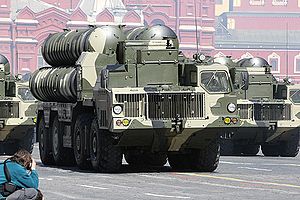SA-10A Grumble
| S-300 Family NATO reporting name: SA-10 Grumble, SA-12 Giant/Gladiator, SA-20 Gargoyle |
|
|---|---|

S-300 anti-aircraft missile system at the Victory Parade, Red Square, 9 May 2009.
|
|
| Type | long-range SAM system |
| Place of origin | Soviet Union |
| Service history | |
| In service | 1978–present |
| Used by | See list of operators |
| Production history | |
| Designer |
|
| Designed | 1967–2005 |
| Manufacturer | MZiK |
| Produced | 1975–2011 (for PS and PM) V/F - free. |
| Variants | see variants |
The S-300 (NATO reporting name SA-10 Grumble) is a series of initially Soviet and later Russian long range surface-to-air missile systems produced by NPO Almaz, based on the initial S-300P version. The S-300 system was developed to defend against aircraft and cruise missiles for the Soviet Air Defence Forces. Subsequent variations were developed to intercept ballistic missiles. The S-300 system was first deployed by the Soviet Union in 1979, designed for the air defence of large industrial and administrative facilities, military bases and control of airspace against enemy strike aircraft. The system is fully automated, though manual observation and operation are also possible. Components may be near the central command post, or as distant as 40 km. Each radar provides target designation for the central command post. The command post compares the data received from the targeting radars up to 80 km apart, filtering false targets, a difficult task at such great distances. The central command post features both active and passive target detection modes.
The project-managing developer of the S-300 is Almaz-Antey. S-300 uses missiles developed by both MKB "Fakel" and NPO Novator design bureaus (separate government corporations, previously named "OKB-2" and "OKB-8").
The S-300 is regarded as one of the most potent anti-aircraft missile systems currently fielded. An evolved version of the S-300 system is the S-400 (NATO reporting name SA-21 Growler), which entered limited service in 2004.
Serial production started in 1975. The tests have been completed in 1978 (P) and 1983 (V + 1987 for anti-ballistic V). Numerous versions have since emerged with different missiles, improved radars, better resistance to countermeasures, longer range and better capability against short-range ballistic missiles or targets flying at very low altitude. There are currently three main variations.
...
Wikipedia
